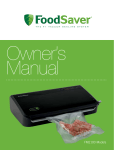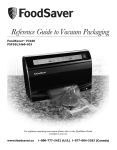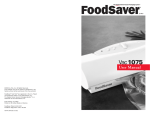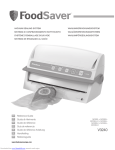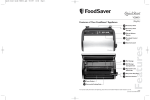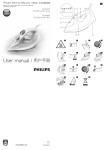Download FSFRSH0051-033
Transcript
Rechargeable Handheld Vacuum System 便携式食品真空保鲜系统 User Guide 用户手册 Model • 型号 FSFRSH0050 www.foodsaver.com.cn READ AND SAVE ALL INSTRUCTIONS BEFORE USING THIS APPLIANCE 使用产品前先阅读此用户手 册并妥善保管 Important Safeguards & Tips Important Safeguards 10. Keep Charger Adapter, power cord and handheld appliance away from heated surfaces. 11. The appliance has Nickel-cadmium batteries. The unit must be recycled or disposed per national and local laws and regulations. DO NOT incinerate batteries or expose to high temperatures or liquids. For your own safety, always follow these basic precautions when using a FoodSaver® appliance: 1. Read the instructions carefully for operating instructions. Read all instructions in this manual before use. 2. Connect the adapter to the power jack of the handheld sealer, and plug the adapter directly to the standard electrical outlet in Mainland China: 220V~50Hz. 3. Do not use appliance on wet or hot surfaces or outdoors. 4. CAUTION: To prevent against electric shock, do not immerse any part of appliance, power cord or plug in water or other liquid. 5. To disconnect, unplug charger adapter from electrical outlet. Do not disconnect by pulling on cord. 6. Do not operate appliance with a damaged power cord or adapter. Do not operate appliance if it malfunctions or is in any way damaged. If the cord or the appliance is damaged, contact our Consumer Service number as listed on the back page of this User Guide. 7. Use appliance only for its intended use. Use only the Charger Adapter supplied with this product. 8. This appliance is not intended for use by persons (including children) with reduced physical, sensory or mental capabilities, or lack of experience and knowledge, unless they have been given supervision or instruction concerning use of the appliance by a person responsible for their safety. Children should be supervised to ensure that they do not play with the appliance. 9. CAUTION: A short power cord is provided to reduce risks from entanglement or tripping over a longer cord. An extension cord may be used when the marked electrical rating is no less than the electrical rating of this appliance. All cords should not drape over counter or tabletop where cords can be tripped over or pulled on unintentionally, especially by children. Important Tips 1. Vacuum packaging is NOT a substitute for the heat process of canning. Perishables still need to be refrigerated. 2. For best results, use only with FoodSaver® Brand Vacuum Zipper Bags and Containers. 3. When vacuum packaging zipper bags, small amounts of liquid, crumbs or food particles can be pulled inadvertently into the Valve, creating a possible air leak. To prevent this, follow these tips: a. For soups, sauces and liquids: Use a container and then place in refrigerator. Sealing liquid in Zipper Bags is NOT recommend. b. For powdery or fine-grained foods: Avoid overfilling bags or use a container. You can also place a coffee filter or paper towel on top of the food beneath the valve before vacuum packaging. c. Ensure the zipper is closed securely and no food debris is trapped in the zipper. Food trapped in the zipper can create a leak, which may cause the bag to loose vacuum over time. 4. Reservoir must be in place during operation. Do not attempt to use without the Reservoir affixed to the Vacuum Nozzle. 5. When using containers, remember to leave 25mm (1 inch) of space at the top of the container. For Household Use Only SAVE THESE INSTRUCTIONS 1 Description of the Appliance 1. 2. 3. 4. Ergonomic design Charge indicator light “Start” button Power jack for the charger adapter 5. Reservoir 6. Charging Base 7. Charger adapter 1 2 3 4 5 6 7 2 Guidelines for vacuum packaging Vacuum Packaging & Food Safety Food Safety Warning The vacuum packaging process extends the life of foods by removing most of the air from sealed zipper bags and containers, thereby reducing oxidation, which affects nutritional value, flavour and overall quality. Removing air can also inhibit growth of micro-organisms, which can cause problems under certain conditions: Use fresh, perishable foods soon after purchase. Even under proper storage conditions, foods lose freshness and nutritive value if they are stored too long. Food Preparation Tips Hard Cheeses: To keep cheese fresh, vacuum package it after each use. Mould – Easily identified by its fuzzy characteristic. Mould cannot grow in a low oxygen environment; therefore vacuum packaging can slow the growth of mould. IMPORTANT: Soft cheeses should never be vacuum packaged. Baked Goods: To vacuum package soft or airy baked goods, we recommend using a FoodSaver® Container so they will hold their shape. Yeast – Results in fermentation, which can be identified by smell and taste. Yeast needs water, sugar and a moderate temperature to grow. It can also survive with or without air. Slowing the growth of yeast requires refrigeration, while freezing stops it completely. Accessories Get the most out of your FoodSaver® appliance with easy-to-use FoodSaver® Bags, Containers and Accessories. Bacteria – Results in an unpleasant odour, discoloration and/or soft or slimy texture. Under the right conditions, Clostridium botulinum (the organism that causes Botulism) can grow without air and sometimes cannot be detected by smell or taste. Although it is extremely rare, it can be very dangerous. FoodSaver ® accessories are available through the consumer service number as listed on the back page of this user guide. To preserve foods safely, it is critical that you maintain low temperatures. It is important to note that vacuum packaging is NOT a substitute for canning and it cannot reverse the deterioration of foods. It can only slow down the changes in quality. It is difficult to predict how long foods will retain their top-quality flavour, appearance or texture because it depends on the age and condition of the food on the day it was vacuumed packaged. 3 Instructions Charging Your Handheld Vacuum Appliance: Before using the appliance for the first time please charge it for at least 24 hours. Failure to do so will reduce the product’s battery life. The charge Indicator Light remains illuminated when the appliance is plugged in. Sealing FoodSaver® Containers (not included) IMPORTANT: Should liquid be collected in the reservoir, stop vacuuming and clean it frequently for smooth operation. Step 1: Fill and Close With FoodSaver® Container on a flat surface – Place food in Container. Set lid on top and apply pressure with both hands to snap into place to prepare for vacuum sealing. Sealing FoodSaver® Vacuum Zipper Bag Step 1: Fill and Seal Bag Place food in FoodSaver® Vacuum Zipper Bag. Lay the Zipper Bag flat with the grey circle facing upwards press zipper firmly to start seal. Slide fingers across the zipper to close the bag. Step 2: Attach FoodSaver® Container Adapter to bottom of Vacuum Nozzle by pushing into bottom as shown. Step 2: Remove Air from Bag Press FoodSaver® Vacuum Sealer over the grey circle on the bag and gently press the Green “Start” button. Step 3: Evacuate Air With the container adapter attached, place the vacuum nozzle tip over the grey valve on container lid. Press “Start” Button on unit and evacuate for 10 seconds. The Container is now ready to be stored. Look for the dimple at the centre of the grey valve – it tells you that air has been removed from the container. Step 3: Refrigerate Place the bag with food into the refrigerator or pantry. Step 4: Release Vacuum To release the vacuum in the Container, simply release the Vacuum Valve/Air Release Flap by gently lifting the tab. *Bags are not intended for liquids. 4 Care, Cleaning & Troubleshooting Container Adapter Storage Troubleshooting 1. Conveniently store Container Adapter on the bottom of the Charging Base as shown. Vacuum sealer does not start when ON Button is pressed: 1. Ensure vacuum sealer is charged. Vacuum Sealer starts but bag does not tighten around food: 1. Ensure zipper is firmly closed. Slide fingers across entire zipper. 2. Air valve is not on flat surface. Reposition bag so the Air Valve lies flat on counter with no food under Air Valve. 3. Do not overfill bag. 4. Do not use excessive force when opening the bag. This could damage the zipper. NOTE: The Container Adapter is included in the Container pack. Care & Cleaning 1. Always unplug appliance before cleaning. 2. Do not immerse appliance in water. 3. Avoid using abrasive products or materials to clean any appliance components. These cleaners can scratch the surface and damage the black foam rubber pads. 4. Use mild dish washing soap and a warm, damp cloth to wipe away food residue inside or around components. 5. Empty Reservoir after each use. Wash in warm soapy water. Air dry before replacing. Vacuum Nozzle and Air Valve are not making secure contact: 1. Ensure Vacuum Nozzle is centered over the grey circle and placed flat on Air Valve. PRESS GENTLY – pressing too hard will result in a failure to remove air from the bag. Air was removed from the bag, but now air has re-entered: 1. Examine zipper and valve of bag. Food debris in zipper or valve may cause leakage and allow air to enter. 2. Sometimes moisture or food material along seal edges of the zipper or beneath the valve prevents bag from sealing properly. Wipe the inside of bag around zipper and beneath value and attempt to reseal. 3. If you are vacuum packaging sharp food items, bag may have been punctured. Use a new bag if there is a hole. Cover sharp food items with a soft cushioning material, such as a paper towel, and reseal. IMPORTANT: To remove Reservoir from Vacuum Nozzle: while holding the Vacuum Nozzle with one hand pull the Reservoir cleanly away from Nozzle. FoodSaver® Containers 1. The Container Base can be safely washed in the top rack of the dishwasher. You can also wash in warm, soapy water; rinse well and dry thoroughly. 2. Do Not attempt to remove grey rubber sucker. 3. FoodSaver® Container bases are top rack dishwasher safe. 4. FoodSaver® Containers are microwave safe. The FoodSaver® Container will not vacuum: 1. Make sure the rubber gasket on inside of lid is free from food materials. 2. Examine rim of container for cracks or scratches. Any gaps can prevent containers from vacuuming properly. 5













